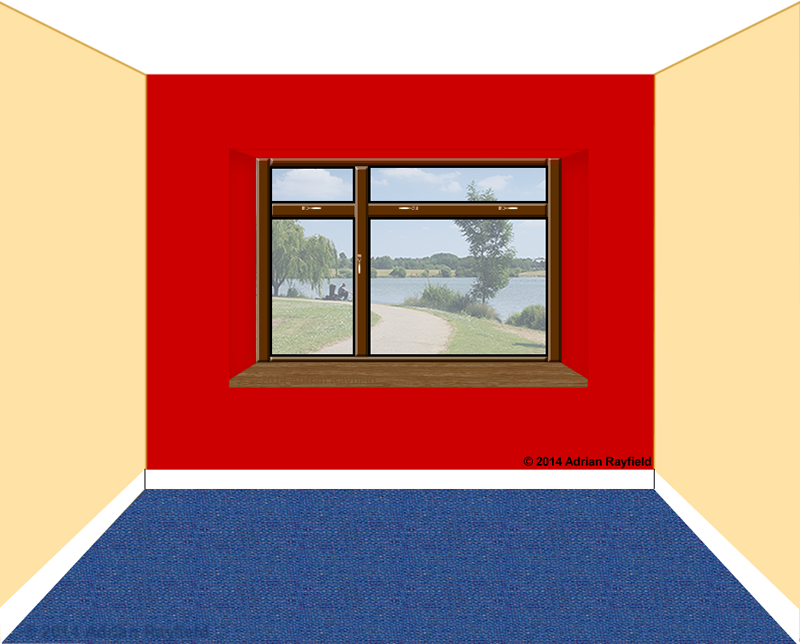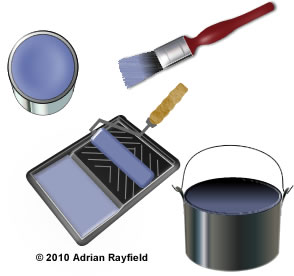Painting, decorating and home improvement tips blog
Feature Walls : How To paint a feature wall
Posted by Adrian
January 14th, 2014
Feature Walls : How To paint a feature wall
Feature walls have become very popular in recent years, they are a great way of giving a room a new look without the expense of changing everything in a room or completely redecorating. Simply by re-painting the feature wall can transform the look of a room. You can also follow the latest trends simply by re-decorating the feature wall.
Feature walls can be painted or wallpapered, it is personal choice and it will depend on the type of look you are going for.
Sometimes a feature all is called an accent wall, but they are both the same thing.
Deciding on paint for a feature wall
Deciding on what colour paint to buy for a feature wall will be determined by how the remaining walls have been decorated, typically a contrasting colour is used. But if the other walls have been wallpapered you can pick a colour from the paper to use as the feature wall colour.
Once you have decided on the colour for your feature wall you can buy the paint, you can buy ‘Feature Wall’ paint, this is just over a litre in size and should be enough to paint one wall. You don’t have to go this route, you can buy any colour in any sized can of paint. You could even use leftover paint if it suits your needs.
If you are unsure how much paint you will require for your feature wall, give our paint calculator a go, simply fill in the required figures and hit the calculate button and you will be told how many litres you need to by for your given area.
Painting a feature wall
To paint your feature wall, you can either mask the adjoining walls, skirting and ceiling with low tack masking tape, then cut in with a brush around the edge of the feature wall, just overlapping the masking tape but being careful not to paint any other surface. The use a roller to fill in the main wall area. By using masking tape you should achieve a straight line.
If you are confident in cutting in you can cut in without masking up. Cutting in is the term used whereby you use a paintbrush to go up to an adjoining surface, be it a wall, ceiling or skirting boards.
Once you have cut in or painted up to the masking tape and painted the first coat onto your feature wall, allow the paint to fully dry before applying a second coat. When you have painted the second coat you can remove the masking tape, if you used any.
Making a statement
By painting a feature wall you are making a statement, and making this one wall the focal point of a room. You may want to do this to highlight some pictures that are hanging on the wall, you maybe make a fireplace the focus of the room or simply it can give orientation to a room.
Whatever the reason for painting a feature wall, it can quickly and easily transform any room and give a focal point to an area of a room.

Tags: Decorating, Emulsion, Feature, Feature Wall, Paint, Paint Calculator, Painting, Statement, Wall
Posted in Decorating Tips | No Comments »
Colour trends for 2014
Posted by Adrian
December 1st, 2013
Colour trends for 2014
Dulux Colour Futures™ from AkzoNobel have come up with the upcoming trends for colour for 2014, through their international research they have selected a range of colours they think will be in trend throughout 2014, and have picked a dominant colour for the year.
Colour palettes and colour trends for 2014
The colour theme is being called ‘Unlocking Potential’
” we see a world in search of answers, which provides us with an open and exciting palette of colours to inspire renewal in the year ahead.”
Quote from ColourFutures™
The theme consists of the following five colour palettes and colour moods:
- Silent Revolution
- Margin of Proof
- Urban Folk
- Secret Garden
- Do It Now!
What is to colour for 2014
The colour of the year 2014 is……. 90GG 19/151 (also known as Teal).
“A tertiary colour, teal is the combination of primary blue and secondary green which today is used to describe several different tones of this majestic colour. Somewhere between blue and green it has come to symbolise balance, but should be combined with neutral tones and shades of wood so as not to overwhelm a space.”
Quote from ColourFutures™
You can see more of this years colour schemes here:
Dulux Trade website or here:
http://www.colourfutures.com and download the Colour Futures book(PDF).
Paint Calculator
If you would like to use the colour of the year (90GG 19/151) or any other colour you need to buy and need to work out how much you need to buy, use our FREE Paint Calculator.
Tags: 2014, 90GG 19/151, AkzoNobel, Colour of the year, Dulux, Dulux Colour Futures, Dulux Trade, Emulsion, Paint, Paint Calculator, Teal, Trends
Posted in Decorating Tips, News, Resources | No Comments »
How do you paint a hall stairs and landing?
Posted by Adrian
January 13th, 2013

How do you paint a hall stairs and landing?
Painting a hall, stairs and landing for a lot of people is a daunting task and too much for them to tackle themselves, so they call a professional decorator like myself to do it for them. A lot of people will not have the ladder to aid them to reach the tallest part, or the stairs are an awkward shape.
Having the right tools makes it safe and easier to do, safety should always be in your mind when painting and decorating but especially if you are painting and decorating your hall, landing and stairs. Falling off a ladder whilst working on a stairway can be very painful.
Painting a hall, stairs and landing
Painting a hall, landing and stairs is just like painting any other interior room, you start at the top and work down.
So, start with preparing the walls, filling and holes and cracks, then paint the ceiling and coving, if you have any. Paint the picture rail next, if you have one, then emulsion the walls, if you have a dado emulsion down to that, then paint the dado before painting the remaining walls below the dado rail. This will save the newly painted wood work getting splashed with emulsion.
Finally, paint the stair stringers (the bit that goes up each side), the spindles and handrail and skirting boards.
And don’t forget the loft hatch if it’s in the hallway.
Wallpapering a hall, stairs and landing
If you are going to wallpaper your hallway, landing and stairs it is similar to wallpapering and interior room, you do all the preparation first, then you paint the ceiling and coving, then paint any woodwork such as picture rail, dado rail and the the stair stringers, spindles and handrail and also the skirting boards.
Once all the paint is dry, the final job is to wallpaper your hall, landing and stairs.
Useful links
Below is a list of useful links you may find help you when either painting or wallpapering your hallway, stairs and landing.
- Wallpaper calculator
- Paint calculator
- Ceiling wallpaper calculator
- How to wallpaper
- How to wallpaper around a door
- How to wallpaper around a window or door reveal
Please feel free to comment below, share this and other posts and follow us on our social media channels.
Tags: Ceiling Wallpaper Calculator, Decorating, Door, Hall stairs landing, Interior Decorating, Paint Calculator, Painting, Reveal, Skirting Boards, Wallpaper, Wallpaper Calculator, Wallpapering, Window
Posted in Decorating Tips | 6 Comments »
